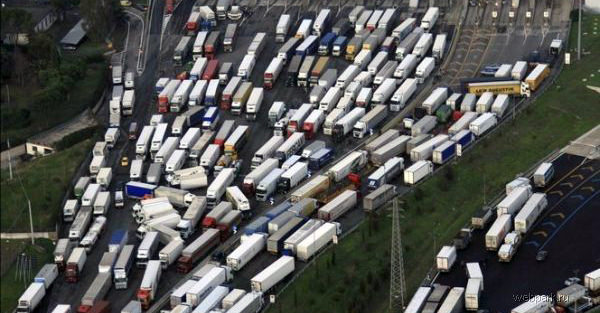Here’s something to think about: How long will the world continue to work if a disaster (a big pandemic, war, etc.) shuts down global transportation?
A think tank in the UK (Chatham House) has come up with an answer: A week.
It will only take a week (at most) before:
- You won’t be able to buy food at the supermarket.
- You can’t find a gas station with any fuel left.
- The government assumes emergency powers to ration what’s left.
As the report states:
One week seems to be the maximum tolerance of the ‘just-in-time’ global economy.
Why will this happen?
Computers, the Internet, and modern business philosophy have radically improved the efficiency of global supply chains. The result is that everything, and I mean everything, is supplied on a just in time basis.
I know because, believe it or not, before I moved here to build my resilient homestead and plant trees rather than shuffle paper in a cubicle, I spent four years in college learning the ins and outs of supply chain management (among other things).
So I’ve done my fair share of logistics calculations using just-in-time formulas, and I can tell you that just-in-time deliveries are great from a business perspective because they can keep inventory low and don’t need to shell out money for as much warehouse space.
It works great… as long as the deliveries keep coming.
But when something happens that disrupts the deliveries, the company is basically screwed because the current inventory will quickly sell out and then they’re left with empty shelves.
And if you rely on that business for your food, water or energy, that means you’re also screwed. Just-in-time principles are dangerous when they’re applied to stuff we need for our survival.

I don’t know about you, but in a crisis I wouldn’t want to depend on trucks like these for my survival.
What do I think about this?
I don’t like being put into positions where I don’t control my future. Situations where I can’t control outcomes.
So, what do I do?
The short term fix is a simple buffer.
Store enough food, water, and other materials to get you through any short term shortage.
It’s common sense really, and I can help you select what you need for that.
Water is most important, as you’ll die in just a few days without it.
FEMA recommends you store at least one gallon of water per person for three days, but I’d recommend you go even further and aim for at least a week’s storage. So if you’re four people in the family you need to store 1 gallon x 7 days x 4 people = 28 gallons of water.
You can buy food grade water storage containers or get started quickly by filling up empty plastic soda bottles.
Then there’s food. FEMA recommends you store at least a three-day supply of non-perishable food but, again, aim for a week’s supply minimum. When you have a week’s supply of food, keep going and aim for a month’s supply. It won’t cost as much as you think if you select the right foods.
The most important advice I can give you here is to store what you eat and eat what you store. Because when you do that, you can rotate the food you have in storage so that it never goes bad.
So if you don’t like freeze-dried mac and cheese, don’t buy a year’s supply of it just because it lasts for a hundred years. I’d skip the military MRE’s as well, mainly because they’re ridiculously overpriced.
If you eat pasta, buy pasta. If you prefer rice, buy rice. Lots of it. Pasta, rice, dried beans, salt, sugar, and more are cheap when you buy in bulk and can be stored for a very long time.
Some other recommended short term emergency food supplies are:
- Ready-to-eat canned meats, fruits, vegetables and a can opener
- Protein or fruit bars
- Dry cereal or granola
- Peanut butter
- Dried fruit
- Nuts
- Crackers
- Canned juices
- Non-perishable pasteurized milk
- High energy foods
- Vitamins
- Food for infants
- Comfort/stress foods
There are many other aspects of short term emergency preparedness that we’ll explore in future posts, however…
The long term solution
The real long term solution is to design your home and community so that it actually produces more of what you need to 1) survive and 2) to thrive.
That means producing more of the food, water, energy, security, happiness etc. that you need to live a good life.
This solution is about real control. It’s about independence.
And when you get to the point where you actually produce more than what you need to survive, then you’re interacting with the world from a position of personal power.
To be in control, you have to go from being a consumer to being a producer.
That’s what self-reliance, and Walden Labs, is all about.
And you don’t need a big farm to do it. Just check out this family in LA growing up to 6,000 lbs on 1/10 of an acre.
If you have a small or even just a tiny space to grow food on, read up on the concept of vertical gardening and check out our Self-Reliance Garden Tower that allows you to grow 50 plants on a tiny 4 square feet.
Right now, until Friday 11th December, we’re running our very first holiday deal for this vertical gardening system. But check it out right away, right here, because the deal expires on Friday at midnight.
We’ll look at more long term solutions in coming articles. Stay tuned.


